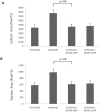α-actinin-4 is essential for maintaining the spreading, motility and contractility of fibroblasts
- PMID: 21085685
- PMCID: PMC2978680
- DOI: 10.1371/journal.pone.0013921
α-actinin-4 is essential for maintaining the spreading, motility and contractility of fibroblasts
Abstract
Background: α-Actinins cross-link actin filaments, with this cross-linking activity regulating the formation of focal adhesions, intracellular tension, and cell migration. Most non-muscle cells such as fibroblasts express two isoforms, α-actinin-1 (ACTN1) and α-actinin-4 (ACTN4). The high homology between these two isoforms would suggest redundancy of their function, but recent studies have suggested different regulatory roles. Interestingly, ACTN4 is phosphorylated upon growth factor stimulation, and this loosens its interaction with actin.
Methodology/principal findings: Using molecular, biochemical and cellular techniques, we probed the cellular functions of ACTN4 in fibroblasts. Knockdown of ACTN4 expression in murine lung fibroblasts significantly impaired cell migration, spreading, adhesion, and proliferation. Surprisingly, knockdown of ACTN4 enhanced cellular compaction and contraction force, and increased cellular and nuclear cross-sectional area. These results, except the increased contractility, are consistent with a putative role of ACTN4 in cytokinesis. For the transcellular tension, knockdown of ACTN4 significantly increased the expression of myosin light chain 2, a element of the contractility machinery. Re-expression of wild type human ACTN4 in ACTN4 knockdown murine lung fibroblasts reverted cell spreading, cellular and nuclear cross-sectional area, and contractility back towards baseline, demonstrating that the defect was due to absence of ACTN4.
Significance: These results suggest that ACTN4 is essential for maintaining normal spreading, motility, cellular and nuclear cross-sectional area, and contractility of murine lung fibroblasts by maintaining the balance between transcellular contractility and cell-substratum adhesion.
Conflict of interest statement
Figures






Similar articles
-
Phosphorylation of alpha-actinin 4 upon epidermal growth factor exposure regulates its interaction with actin.J Biol Chem. 2010 Jan 22;285(4):2591-600. doi: 10.1074/jbc.M109.035790. Epub 2009 Nov 17. J Biol Chem. 2010. PMID: 19920151 Free PMC article.
-
α-Actinin-4 drives invasiveness by regulating myosin IIB expression and myosin IIA localization.J Cell Sci. 2021 Dec 1;134(23):jcs258581. doi: 10.1242/jcs.258581. Epub 2021 Dec 6. J Cell Sci. 2021. PMID: 34730180
-
Nonmuscle myosin II isoform and domain specificity during early mouse development.Proc Natl Acad Sci U S A. 2010 Aug 17;107(33):14645-50. doi: 10.1073/pnas.1004023107. Epub 2010 Aug 2. Proc Natl Acad Sci U S A. 2010. PMID: 20679233 Free PMC article.
-
Mammalian nonmuscle myosin II comes in three flavors.Biochem Biophys Res Commun. 2018 Nov 25;506(2):394-402. doi: 10.1016/j.bbrc.2018.03.103. Epub 2018 Mar 17. Biochem Biophys Res Commun. 2018. PMID: 29550471 Free PMC article. Review.
-
Of mice and men: Relevance of cellular and molecular characterizations of myosin IIA to MYH9-related human disease.Cell Adh Migr. 2007 Jul-Sep;1(3):152-5. doi: 10.4161/cam.1.3.5089. Epub 2007 Jul 26. Cell Adh Migr. 2007. PMID: 19262128 Free PMC article. Review.
Cited by
-
The F-actin bundler α-actinin Ain1 is tailored for ring assembly and constriction during cytokinesis in fission yeast.Mol Biol Cell. 2016 Jun 1;27(11):1821-33. doi: 10.1091/mbc.E16-01-0010. Epub 2016 Apr 13. Mol Biol Cell. 2016. PMID: 27075176 Free PMC article.
-
Identification of dynamic changes in proteins associated with the cellular cytoskeleton after exposure to okadaic acid.Mar Drugs. 2013 May 24;11(6):1763-82. doi: 10.3390/md11061763. Mar Drugs. 2013. PMID: 23708184 Free PMC article.
-
Differential expression profiles of long non‑coding RNAs during the mouse pronuclear stage under normal gravity and simulated microgravity.Mol Med Rep. 2019 Jan;19(1):155-164. doi: 10.3892/mmr.2018.9675. Epub 2018 Nov 20. Mol Med Rep. 2019. PMID: 30483791 Free PMC article.
-
Sarcomeric and nonmuscle α-actinin isoforms exhibit differential dynamics at skeletal muscle Z-lines.Cytoskeleton (Hoboken). 2018 May;75(5):213-228. doi: 10.1002/cm.21442. Epub 2018 Apr 1. Cytoskeleton (Hoboken). 2018. PMID: 29518289 Free PMC article.
-
The fifth sense: Mechanosensory regulation of alpha-actinin-4 and its relevance for cancer metastasis.Semin Cell Dev Biol. 2017 Nov;71:68-74. doi: 10.1016/j.semcdb.2017.05.024. Epub 2017 Jun 1. Semin Cell Dev Biol. 2017. PMID: 28579451 Free PMC article. Review.
References
-
- Otey CA, Carpen O. Alpha-actinin revisited: a fresh look at an old player. Cell Motil Cytoskeleton. 2004;58:104–111. - PubMed
-
- Quick Q, Skalli O. Alpha-actinin 1 and alpha-actinin 4: contrasting roles in the survival, motility, and RhoA signaling of astrocytoma cells. Exp Cell Res. 2010;316:1137–1147. - PubMed
-
- Michaud JL, Hosseini-Abardeh M, Farah K, Kennedy CR. Modulating alpha-actinin-4 dynamics in podocytes. Cell Motil Cytoskeleton. 2009;66:166–178. - PubMed
-
- Honda K, Yamada T, Hayashida Y, Idogawa M, Sato S, et al. Actinin-4 increases cell motility and promotes lymph node metastasis of colorectal cancer. Gastroenterology. 2005;128:51–62. - PubMed
Publication types
MeSH terms
Substances
Grants and funding
LinkOut - more resources
Full Text Sources
Molecular Biology Databases
Miscellaneous

